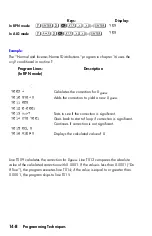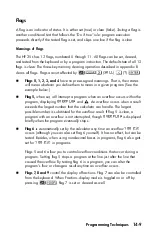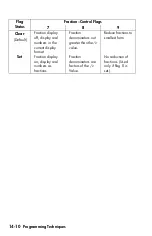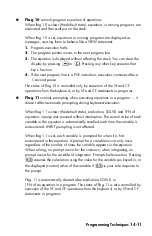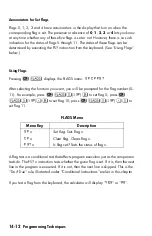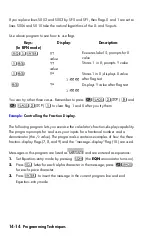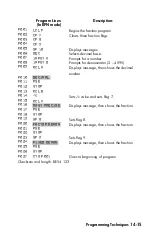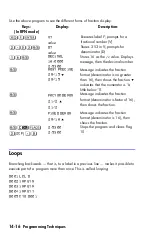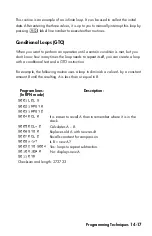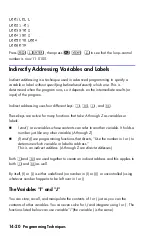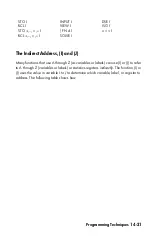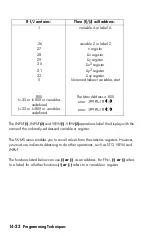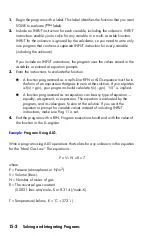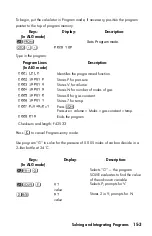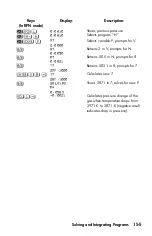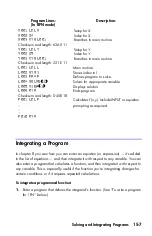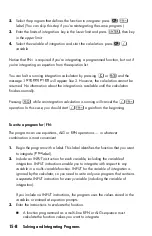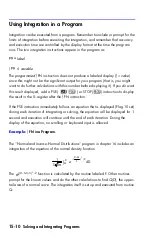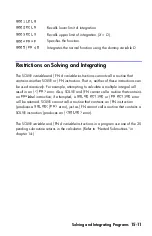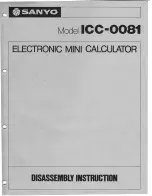
14-20
Press
L
, then press
Z
to see that the loop–control
number is now 11.0100.
Indirectly Addressing Variables and Labels
Indirect addressing
is a technique used in advanced programming to specify a
variable or label
without specifying beforehand exactly which one
. This is
determined when the program runs, so it depends on the intermediate results (or
input) of the program.
Indirect addressing uses four different keys:
0
,
7
,
1
, and
A
.
These keys are active for many functions that take
A
through
Z
as variables or
labels.
I and J
are variables whose contents can refer to another variable. It holds a
number just like any other variable (
A
through
Z
).
(I) and (J)
are programming functions that directs, "Use the number in I or J to
determine which variable or label to address."
This is an
indirect address
. (A through Z are
direct addresses
.)
Both
0
and
7
are used together to create an indirect address and this applies to
both
1
and
A
as well.
By itself, (I) or (J) is either undefined (no number in (I) or (J)) or uncontrolled (using
whatever number happens to be left over in I or J).
The Variables "I" and "J"
You can store, recall, and manipulate the contents of I or J just as you can the
contents of other variables. You can even solve for
I,J
and integrate using I or J . The
functions listed below can use variable "
i
"(the variable J is the same).
Summary of Contents for 35s
Page 1: ...HP 35s scientific calculator user s guide H Edition 1 HP part number F2215AA 90001 ...
Page 14: ...12 Contents ...
Page 15: ...Part 1 Basic Operation ...
Page 16: ......
Page 46: ...1 30 Getting Started ...
Page 63: ...RPN The Automatic Memory Stack 2 17 A Solution ...
Page 64: ...2 18 RPN The Automatic Memory Stack ...
Page 74: ...3 10 Storing Data into Variables ...
Page 180: ...12 14 Statistical Operations ...
Page 181: ...Part 2 Programming ...
Page 182: ......
Page 246: ...15 12 Solving and Integrating Programs ...
Page 270: ...16 24 Statistics Programs ...
Page 284: ...17 14 Miscellaneous Programs and Equations ...
Page 285: ...Part 3 Appendixes and Reference ...
Page 286: ......
Page 308: ...B 8 User Memory and the Stack ...
Page 322: ...C 14 ALG Summary ...
Page 336: ...D 14 More about Solving ...
Page 346: ...E 10 More about Integration ...
Page 352: ...F 6 Messages ...
Page 370: ...G 18 Operation Index ...
Page 382: ...Index 12 ...



